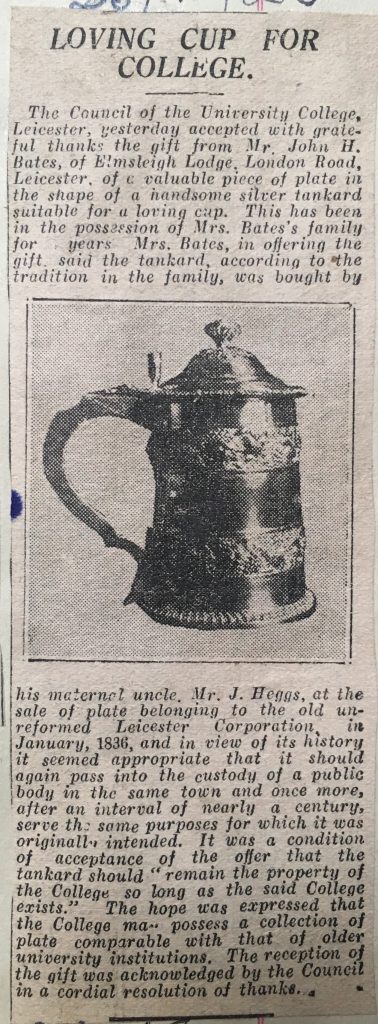Volunteer Caroline Wessel uncovers a link between the University of Leicester and a famous English naturalist

On 26 November 1926 the Leicester Mail reported that ‘a valuable piece of plate in the shape of a handsome silver tankard suitable for a loving cup’ had been given to the University College, Leicester, by Mr John Heggs Bates, of a Leicester hosiery manufacturing family. The loving cup, handed over by his mother, Mrs Martha Bates, had been in the possession of the Bates family for many years, and was apparently bought by her maternal uncle, Mr J. Heggs, at the sale of plate belonging to the unreformed Leicester Corporation in 1836. Mrs Bates felt that ‘in view of its history it seemed appropriate that it should again pass into the custody of a public body in the same town and once more, after an interval of nearly a century, serve the same purposes for which it was originally intended’.
The old Leicester Corporation, run mainly by Tories and Anglicans, had become grossly in debt and when it was reformed in 1835 many of its new councillors were Liberal Nonconformists. Therefore the archaic offices of the mace-bearer, four sergeants-at-mace, two bellmen, town crier, six town waits, beadle, and mole-catcher were abolished and
as it had been decided to put an end to the civic feasts which had been a feature of the old regime, the town’s large stock of plate, crockery, cutlery, glass, and table linen was sold, and in the momentary enthusiasm for clearing away everything connected with the pomp, carousals, and corruption of the unreformed corporation the town’s seventeenth-century great mace, with some lesser pieces of civic regalia, was also auctioned.
Thus this historic piece of civic silver found its way to the University, via the Bates family.
John Heggs Bates was a signatory to the College’s original Memorandum and Articles (where he is described as of independent means). He made an early donation to the College, and when he died in 1949 left £10,000 to the University. However it may not be generally known that the microscopes and memorials he also gave were those belonging to his most eminent kinsman, the Victorian naturalist and explorer Henry Walter Bates who wrote the first scientific account of mimicry in animals – but is probably most famous for his expedition to the Amazon rainforests with his friend and fellow naturalist Alfred Wallace.

Explorer Henry Bates (1825-1892) was born in Leicester to a literate middle class family, left school aged thirteen and was apprenticed to a hosiery manufacturer. In his spare time he eagerly studied books in the Mechanics’ Institute library and collected insects in Charnwood Forest. He became friends with Alfred Russel Wallace when the latter took up a teaching post at Leicester Collegiate School and together they read books by Darwin and Huxley and vigorously discussed the theories of evolution. To pursue their interest in the origin of the species, they decided to embark on a journey to the Amazon and set off in 1848. Wallace returned in 1852, but lost his collection in a shipwreck. When Bates arrived home in 1859 after a full eleven years, he had sent back over 14,712 species (mostly of insects) of which 8,000 were apparently new to science. Bates wrote up his findings in his best-known work The Naturalist on the River Amazons: a record of adventures, habits of animals, sketches of Brazilian and Indian life, and aspects of nature under the Equator, during eleven years of travel, a copy of which was in the extensive book collection from Mr Fielding Johnson’s library donated by his daughter in 1919, now housed in the University’s Special Collections. Did Fielding Johnson own this book because he was acquainted with Henry Bates? They were contemporaries, born just three years apart, and both had connections with the Leicester hosiery trade, so it seems a possibility.
John Heggs Bates is still remembered in Leicestershire today through the John Heggs Bates Charity he set up to provide grants for convalescents breaks for necessitous convalescents and their carers who reside in Leicester, Leicestershire or Rutland. These days the Charity uses the services of Charity Link, a Leicester organisation founded in 1876 which during the 1920s was proud to have at least 120 subscribers who were also supporters of the new University College.
Note: It was a condition of acceptance of the Bates silver tankard that it should ‘remain the property of the college so long as the said College exist’.
Key Sources
Victoria County History: vol. 4, City of Leicester (1958) p.251
Burch, Brian (unpublished, undated) The Making of a University in Leicester ULA/D12/1.
Bates, Henry Walter (1863) The Naturalist on the River Amazons: a record of adventures, habits of animals, sketches of Brazilian and Indian life, and aspects of nature under the Equator, during eleven years of travel.
Charity Link archives – thanks to Jim Munton for sourcing this information.